Development of Magnesium Phosphate Cement Based on Low-Grade MgO
Abstract
1. Introduction
2. Materials and Methods
2.1. Materials
2.2. Preparation of MKPC Pastes and Mortars
2.3. Experimental Methods
3. Results and Discussion
3.1. Mechanical Strengths of MKPC Pastes
3.2. Characterization of MKPC Pastes
3.3. Changes in the Microstructure of MKPC Pastes
3.4. Changes in the Volume Stability of MKPC Mortars
4. Conclusions
- A low-grade MgO (~58% MgO) can be effectively used to produce MKPC cements. The presence of secondary minor phases (such as magnesite, dolomite, anhydrite, and quartz) does not affect the formation of the main reaction product, K-struvite crystals.
- The M/P molar ratio and relative humidity are key parameters to be considered in the design of MKPC cements. At a lower M/P ratio (M/P 1), the high phosphate content can induce the formation of secondary phases different from the K-struvite. Additionally, elevated relative humidity promotes efflorescence formation, altering the microstructure and porosity, which in turn affects the mechanical strength.
- For samples prepared with M/P 2, 3, and 4, K-struvite is the primary reaction product regardless of relative humidity conditions. However, the formation of secondary crystalline phases, such as Mg2KH(PO4)2·15H2O and Mg3(PO4)2·22H2O, is favored in samples cured at high relative humidity. Additionally, the co-precipitation of an amorphous phase composed of Mg, P, and K with little to no water content was confirmed under both curing conditions.
- Systems prepared with an M/P ratio of 3 achieved compressive strengths exceeding 60 MPa under both relative humidity conditions after 28 days. Additionally, the microstructure (total porosity and pore size distribution), the stable mineralogy (the mayor reaction product is K-struvite), and the good volume stability, make this formulation a potential candidate for the encapsulation of LL and IL nuclear waste.
Author Contributions
Funding
Institutional Review Board Statement
Informed Consent Statement
Data Availability Statement
Acknowledgments
Conflicts of Interest
References
- Covill, A.; Hyatt, N.C.; Hill, J.; Collier, N.C. Development of magnesium phosphate cements for encapsulation of radioactive waste. Adv. Appl. Ceram. 2011, 110, 151–156. [Google Scholar] [CrossRef]
- Garcia-Lodeiro, I.; Wuen, K.O.; Irisawa, K.; Kinoshita, H. Use of NaH2PO4 and Na(PO3)n as a phosphate source for development of magnesium phosphate cements. In Proceedings of the 27 Cement and Concrete Science Conference, London, UK, 10–11 February 2017; p. 65. [Google Scholar]
- Gardner, L.J. Assessment of Magnesium Potassium Phosphate Cements for Radioactive Waste Encapsulation. Ph.D. Dissertation, University of Sheffield, Sheffield, UK, 2016. [Google Scholar]
- IAEA-TECDOC-1572; Disposal Aspects of Low and Intermediate Level Decommissioning Waste. IAEA: Vienna, Austria, 2007; ISBN 978-92-0-109107-9. ISSN 1011-4289.
- Hyatt, N.C.; Ojovan, M.I. Materials for nuclear waste immobilization. Materials 2019, 12, 3611. [Google Scholar] [CrossRef] [PubMed]
- Ojovan, M.I.; Lee, W.E. Introduction to Immobilisation. In An Introduction to Nuclear Waste Immobilisation; Elsevier: Oxford, UK, 2013; Chapter 1; pp. 1–8. [Google Scholar]
- Glasser, F.P. Fundamental aspects of cement solidification and stabilisation. J. Hazard. Mater. 1997, 52, 151–170. [Google Scholar] [CrossRef]
- Le Caër, S. Water radiolysis: Influence of oxide surfaces on H2 production under ionizing radiation. Water 2011, 3, 235–253. [Google Scholar] [CrossRef]
- Saji, G. Review on Water Radiolysis in the Fukushima Daiichi Accident: Potential Cause of Hydrogen Generation and Explosion. In Proceedings of the International Conference on Nuclear Engineering, Prague, Czech Republic, 7 July 2014; American Society of Mechanical Engineers: New York, NY, USA, 2014; Volume 45899, p. V001T02A026. [Google Scholar]
- Zhou, Q.; Milestone, N.B.; Hayes, M. An alternative to Portland cement for waste encapsulation—The calcium sulfoaluminate cement system. J. Hazard. Mater. 2006, 136, 120–129. [Google Scholar] [CrossRef]
- Perera, D.S.; Blackford, M.G.; Vance, E.R.; Hanna, J.V.; Finnie, K.S.; Nicholson, C.L. Geopolymers for the immobilization of radioactive waste. MRS Online Proc. Libr. (OPL) 2004, 824, CC8–CC35. [Google Scholar] [CrossRef]
- Swift, P.; Kinoshita, H.; Collier, N.C.; Utton, C.A. Phosphate modified calcium aluminate cement for radioactive waste encapsulation. Adv. Appl. Ceram. 2013, 112, 1–8. [Google Scholar] [CrossRef]
- Irisawa, K.; Garcia-Lodeiro, I.; Kinoshita, H. Influence of mixing solution on characteristics of calcium aluminate cement modified with sodium polyphosphate. Cem. Concr. Res. 2020, 128, 105951. [Google Scholar] [CrossRef]
- Irisawa, K.; Namiki, M.; Taniguchi, T.; Garcia-Lodeiro, I.; Kinoshita, H. Solidification and stabilization of strontium and chloride ions in thermally treated calcium aluminate cement modified with or without sodium polyphosphate. Cem. Concr. Res. 2022, 156, 106758. [Google Scholar] [CrossRef]
- Garcia-Lodeiro, I.; Irisawa, K.; Jin, F.; Meguro, Y.; Kinoshita, H. Reduction of water content in calcium aluminate cement with/out phosphate modification for alternative cementation technique. Cem. Concr. Res. 2018, 109, 243–253. [Google Scholar] [CrossRef]
- Walling, S.A.; Provis, J.L. Magnesia-based cements: A journey of 150 years, and cements for the future? Chem. Rev. 2016, 116, 4170–4204. [Google Scholar] [CrossRef] [PubMed]
- Haque, M.A.; Chen, B. Research progresses on magnesium phosphate cement: A review. Constr. Build. Mater. 2019, 211, 885–898. [Google Scholar] [CrossRef]
- Gardner, L.J.; Corkhill, C.L.; Walling, S.A.; Vigor, J.E.; Murray, C.A.; Tang, C.C.; Provis, J.L.; Hyatt, N.C. Early age hydration and application of blended magnesium potassium phosphate cements for reduced corrosion of reactive metals. Cem. Concr. Res. 2021, 143, 106375. [Google Scholar] [CrossRef]
- Coumes, C.C.; Lambertin, D.; Lahalle, H.; Antonucci, P.; Cannes, C.; Delpech, S. Selection of a mineral binder with potentialities for the stabilization/solidification of aluminum metal. J. Nucl. Mater. 2014, 453, 31–40. [Google Scholar] [CrossRef]
- Perona, R.; Fernández-García, C.; García-Lodeiro, I.; Criado, M.; Bastidas, J.M.; Alonso, M.C. Corrosion behavior and immobilization of pure aluminum and Al− Mg alloy LLRW in magnesium potassium phosphate cements. J. Nucl. Mater. 2023, 582, 154501. [Google Scholar] [CrossRef]
- Qian, J. Magnesium Phosphate Cement (Chapter 4) in the Book Magnesia Cements; Elsevier Inc.: Amsterdam, The Netherlands, 2020. [Google Scholar] [CrossRef]
- Maldonado-Alameda, A.; Lacasta, A.M.; Giro-Paloma, J.; Chimenos, J.M.; Haurie, L.; Formosa, J. Magnesium phosphate cements formulated with low grade magnesium oxide incorporating phase change materials for thermal energy storage. Constr. Build. Mater. 2017, 155, 209–216. [Google Scholar] [CrossRef]
- Niubó, M.; Formosa, J.; Maldonado-Alameda, A.; del Valle-Zermeño, R.; Chimenos, J.M. Magnesium phosphate cement formulated with low grade magnesium oxide with controlled porosity and low thermal conductivity as a function of admixture. Ceram. Int. 2016, 42, 15049–15056. [Google Scholar] [CrossRef]
- Opara, E.U.; Karthäuser, J.; Köhler, R.; Kowald, T.; Koddenberg, T.; Mai, C. Low-carbon magnesium potassium phosphate cement (MKPC) binder comprising caustic calcined magnesia and potassium hydroxide activated biochar from softwood technical lignin. Constr. Build. Mater. 2023, 398, 132475. [Google Scholar] [CrossRef]
- Jones, G.C.; Jakson, B. .Infrared Transmission Spectra of Carbonate Minerals, Natural History Museum; Springer: Berlin/Heidelberg, Germany, 1993; ISBN 978-94-010-4940-5/978-94-011-2120-0. [Google Scholar] [CrossRef]
- Farmer, V.C. The infrared spectra of minerals. Mineral. Soc. Monogr. 1974, 4, 331–363. [Google Scholar]
- Jastrzębski, W.; Sitarz, M.; Rokita, M.; Bułat, K. Infrared spectroscopy of different phosphates structures. Spectrochim. Acta Part A Mol. Biomol. Spectrosc. 2011, 79, 722–727. [Google Scholar] [CrossRef]
- Sun, C.; Xu, D.; Xue, D. In situ FTIR-ATR observation of structural dynamics of H2PO4− in precrystallisation solution. Mater. Res. Innov. 2014, 18, 370–375. [Google Scholar] [CrossRef]
- Ribeiro, D.V.; Paula, G.R.; Morelli, M.R. Effect of boric acid content on the properties of magnesium phosphate cement. Constr. Build. Mater. 2019, 214, 557–564. [Google Scholar] [CrossRef]
- DIN EN 196-1; Methods of Testing Cement—Part 1: Determination of Strength. European Standards: Bruxelles, Belgium, 2016.
- Xu, B.; Lothenbach, B.; Leemann, A.; Winnefeld, F. Reaction mechanism of magnesium potassium phosphate cement with high magnesium-to-phosphate ratio. Cem. Concr. Res. 2018, 108, 140–151. [Google Scholar] [CrossRef]
- Le Rouzic, M.; Chaussadent, T.; Stefan, L.; Saillio, M. On the influence of Mg/P ratio on the properties and durability of magnesium potassium phosphate cement pastes. Cem. Concr. Res. 2017, 96, 27–41. [Google Scholar] [CrossRef]
- Chong, L.; Yang, J.; Shi, C. Effect of curing regime on water resistance of magnesium–potassium phosphate cement. Constr. Build. Mater. 2017, 151, 43–51. [Google Scholar] [CrossRef]
- Wu, J.; Lai, Z.; Deng, Q.; Liu, M. Effects of various curing conditions on volume stability of magnesium phosphate cement. Adv. Mater. Sci. Eng. 2021, 2021, 6652363. [Google Scholar] [CrossRef]
- Li, T.; Chen, G.; Yang, J.; Chong, L.; Hu, X. Influence of curing conditions on mechanical properties and microstructure of magnesium potassium phosphate cement. Case Stud. Constr. Mater. 2022, 17, e01264. [Google Scholar] [CrossRef]
- Lothenbach, B.; Xu, B.; Winnefeld, F. Thermodynamic data for magnesium (potassium) phosphates. Appl. Geochem. 2019, 111, 104450. [Google Scholar] [CrossRef]
- Chauhan, C.K.; Vyas, P.M.; Joshi, M.J. Growth and characterization of Struvite-K crystals. Cryst. Res. Technol. 2011, 46, 187–194. [Google Scholar] [CrossRef]
- Gardner, L.J.; Walling, S.A.; Lawson, S.M.; Sun, S.; Bernal, S.A.; Corkhill, C.L.; Provis, J.L.; Apperley, D.C.; Iuga, D.; Hanna, J.V.; et al. Characterization of and structural insight into struvite-K, MgKPO4·6H2O, an analogue of struvite. Inorg. Chem. 2020, 60, 195–205. [Google Scholar] [CrossRef]
- Chhaiba, S.; Martinez-Sanchez, S.; Husillos-Rodriguez, N.; Palomo, Á.; Kinoshita, H.; Garcia-Lodeiro, I. Durability of Magnesium Potassium Phosphate Cements (MKPCs) under Chemical Attack. Materials 2024, 17, 4252. [Google Scholar] [CrossRef] [PubMed]
- Tan, Y.; Gardner, L.J.; Walkley, B.; Hussein, O.H.; Ding, H.; Sun, S.; Yu, H.; Hyatt, N.C. Optimization of magnesium potassium phosphate cements using ultrafine fly ash and fly ash. ACS Sustain. Chem. Eng. 2023, 11, 3194–3207. [Google Scholar] [CrossRef] [PubMed]
- Földvári, M. Handbook of Thermogravimetric System of Minerals and Its Use in Geological Practice; Geological Institute of Hungary: Budapest, Hungary, 2011. [Google Scholar]
- Umbreit, M.H.; Paukszta, D. The influence of temperature (20–1000 °C) on binary mixtures of solid solutions of CH3COOLi·2H2O–MgHPO4·3H2O. Phys. B Condens. Matter 2009, 404, 3620–3636. [Google Scholar] [CrossRef]
- Scrimgeour, S.N.; Chudek, J.A.; Cowper, G.A.; Lloyd, C.H. 31P solid-state MAS-NMR spectroscopy of the compounds that form in phosphate-bonded dental casting investment materials during setting. Dent. Mater. 2007, 23, 934–943. [Google Scholar] [CrossRef]
- Zhang, G.; Wang, Q.; Li, Y.; Zhang, M. Microstructure and micromechanical properties of magnesium phosphate cement. Cem. Concr. Res. 2023, 172, 107227. [Google Scholar] [CrossRef]
- Lahalle, H.; Coumes, C.C.; Mercier, C.; Lambertin, D.; Cannes, C.; Delpech, S.; Gauffinet, S. Influence of the w/c ratio on the hydration process of a magnesium phosphate cement and on its retardation by boric acid. Cem. Concr. Res. 2018, 109, 159–174. [Google Scholar] [CrossRef]
- Viani, A.; Mali, G.; Mácová, P. Investigation of amorphous and crystalline phosphates in magnesium phosphate ceramics with solid-state 1H and 31P NMR spectroscopy. Ceram. Int. 2017, 43, 6571–6579. [Google Scholar] [CrossRef]
- Sannigrahi, P.; Ingall, E. Polyphosphates as a source of enhanced P fluxes in marine sediments overlain by anoxic waters: Evidence from 31P NMR. Geochem. Trans. 2005, 6, 52. [Google Scholar] [CrossRef]
- Abdelrazig, B.E.; Sharp, J.H.; El-Jazairi, B. The microstructure and mechanical properties of mortars made from magnesia-phosphate cement. Cem. Concr. Res. 1989, 19, 247–258. [Google Scholar] [CrossRef]
- Xu, B.; Winnefeld, F.; Kaufmann, J.; Lothenbach, B. Influence of magnesium-to-phosphate ratio and water-to-cement ratio on hydration and properties of magnesium potassium phosphate cements. Cem. Concr. Res. 2019, 123, 105781. [Google Scholar] [CrossRef]
- Li, Y.; Chen, B. Factors that affect the properties of magnesium phosphate cement. Constr. Build. Mater. 2013, 47, 977–983. [Google Scholar] [CrossRef]
- Koleva, V.; Stefov, V.; Najdoski, M.; Cahil, A. Thermal, spectral and microscopic studies of water-rich hydrate of the type Mg2KH(PO4)2·15H2O. Thermal transformations. Thermochim. Acta 2015, 619, 20–25. [Google Scholar] [CrossRef]
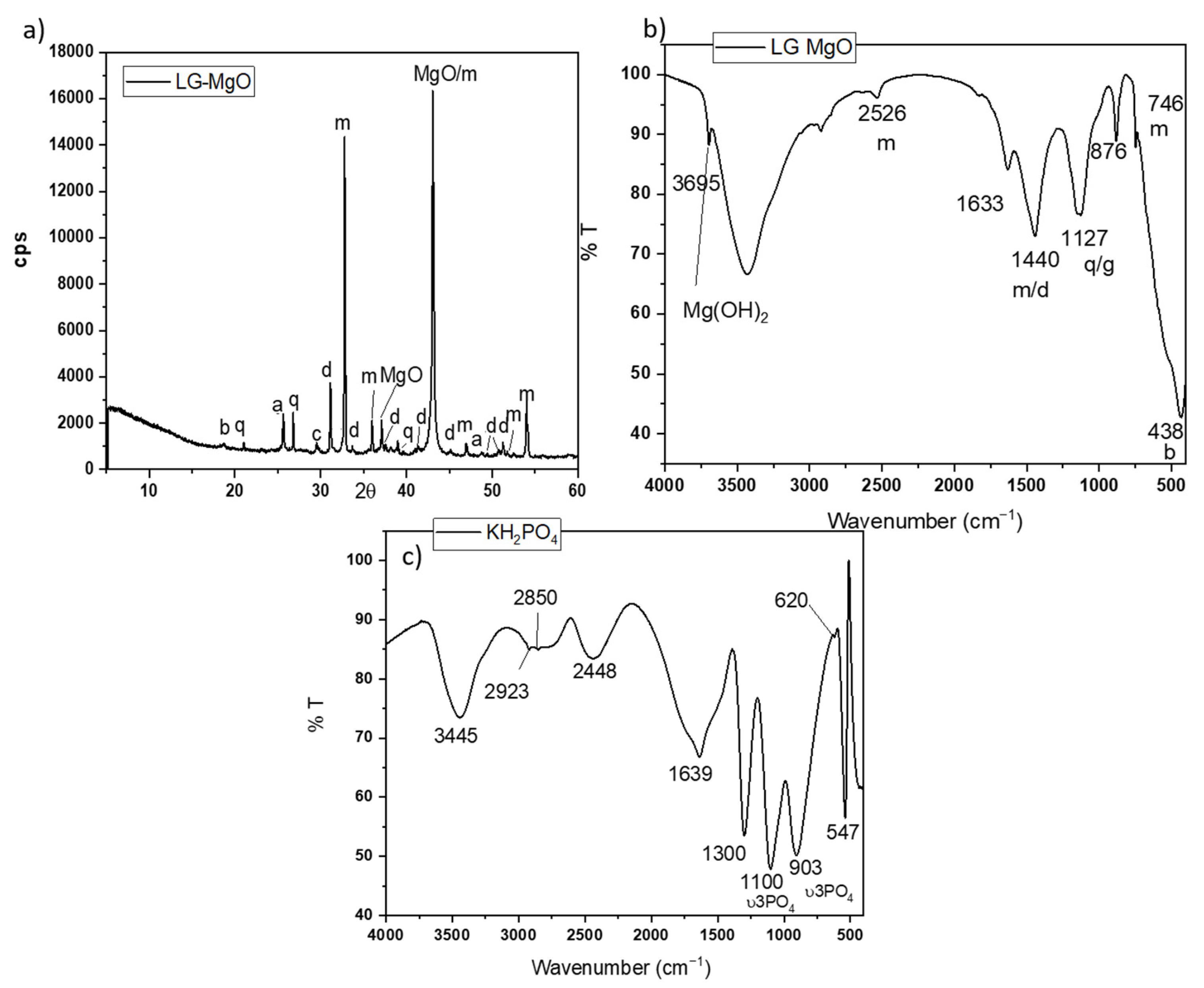
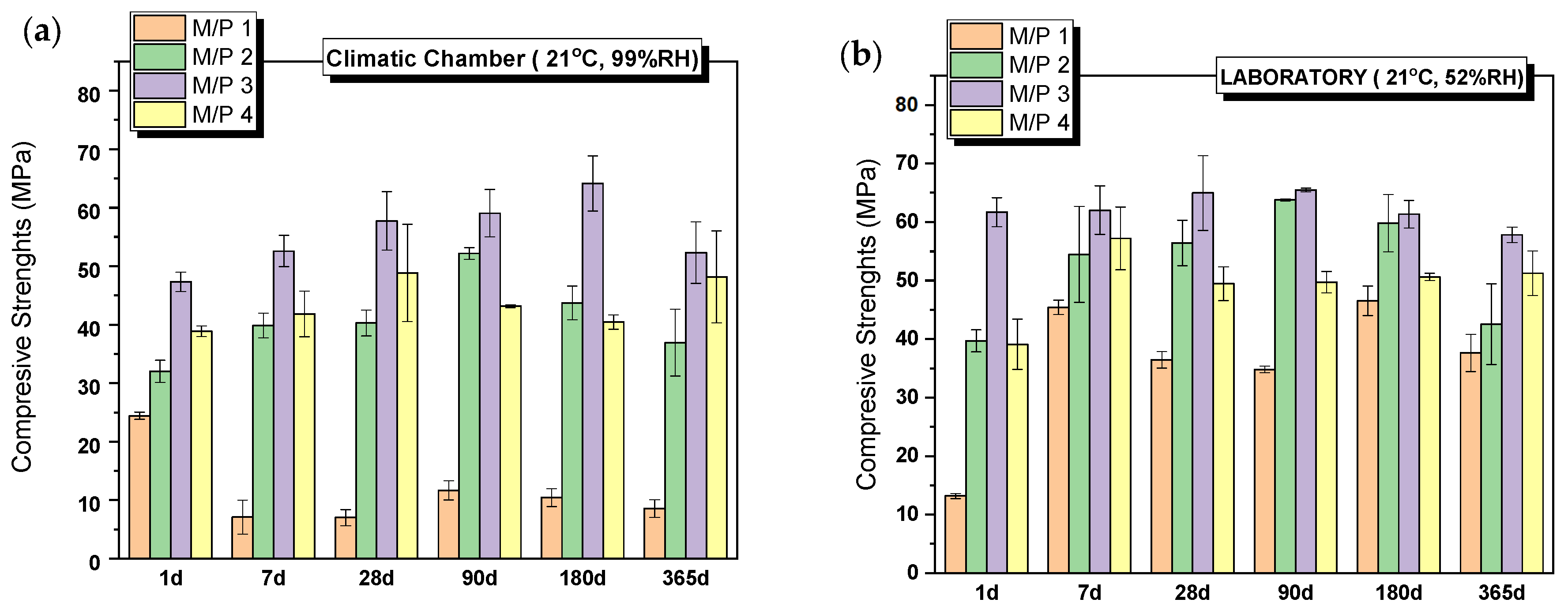
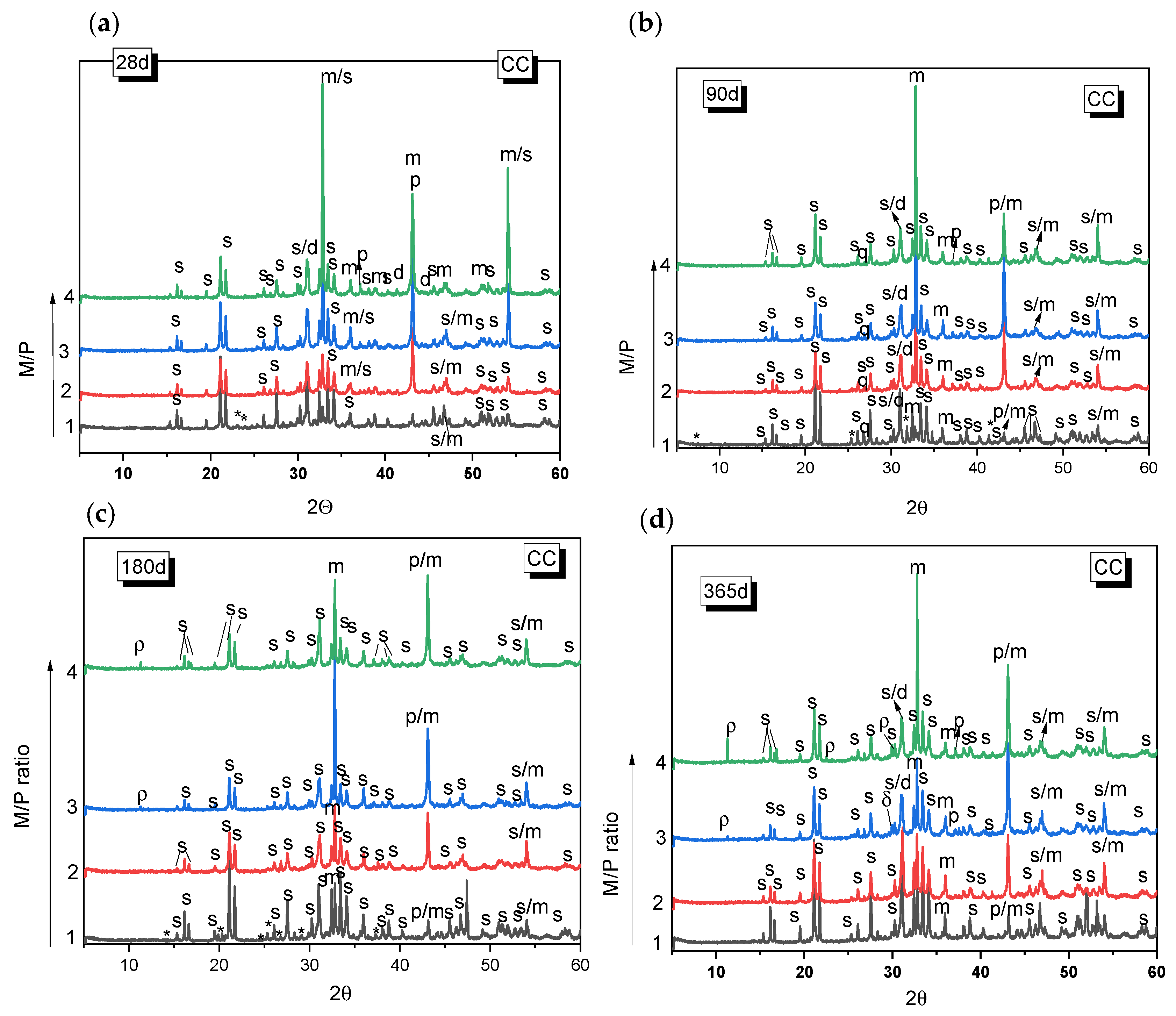
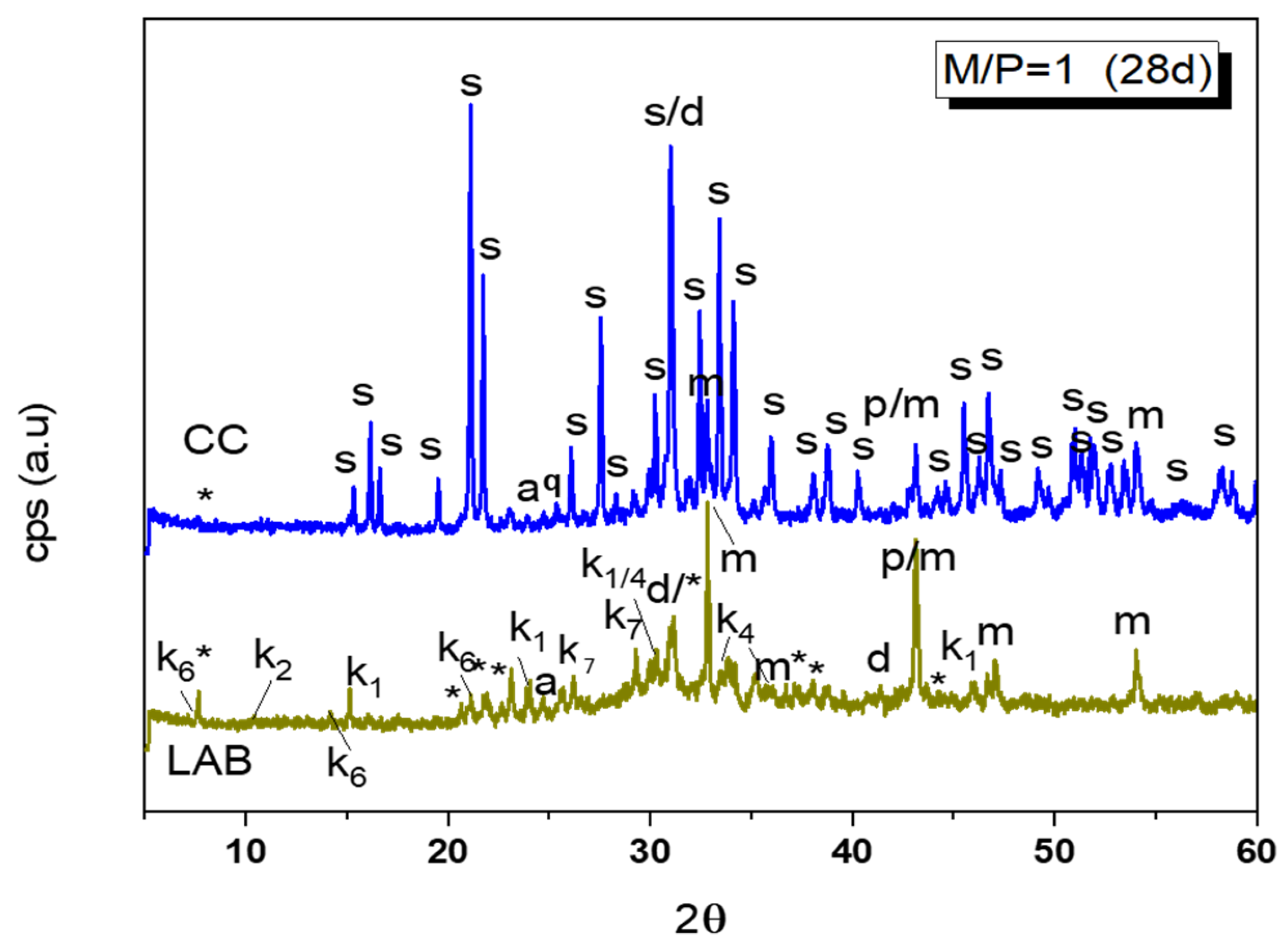
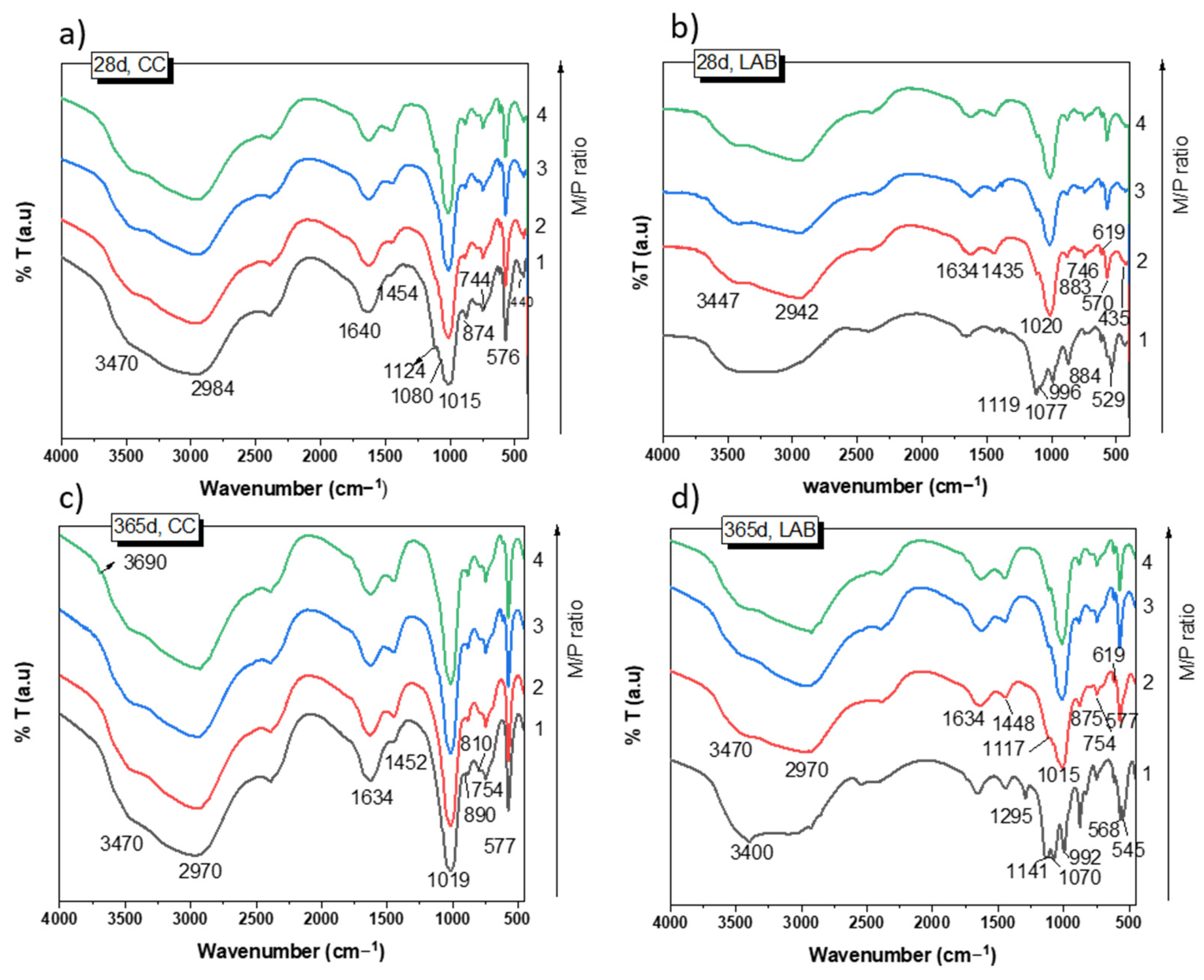

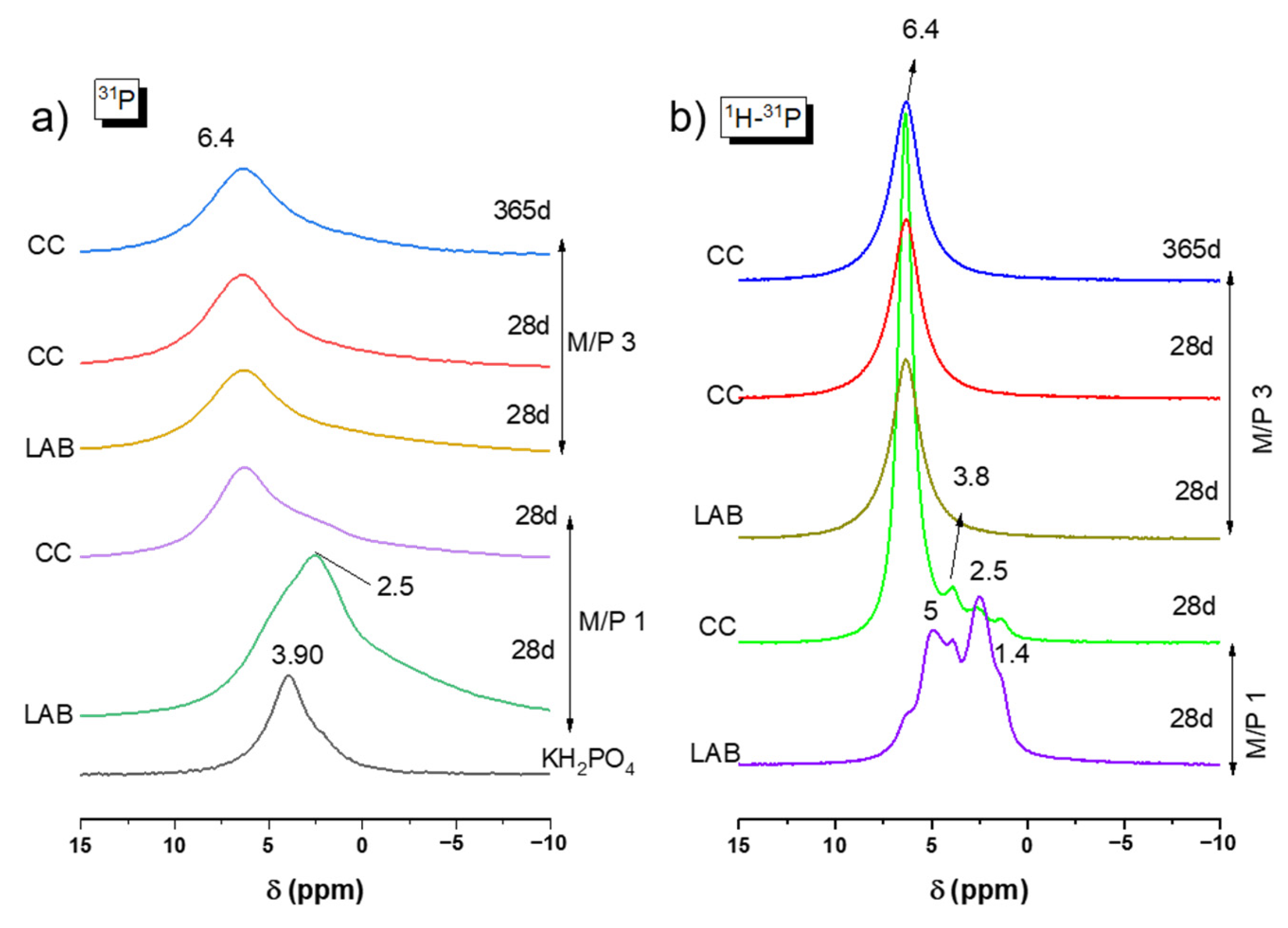
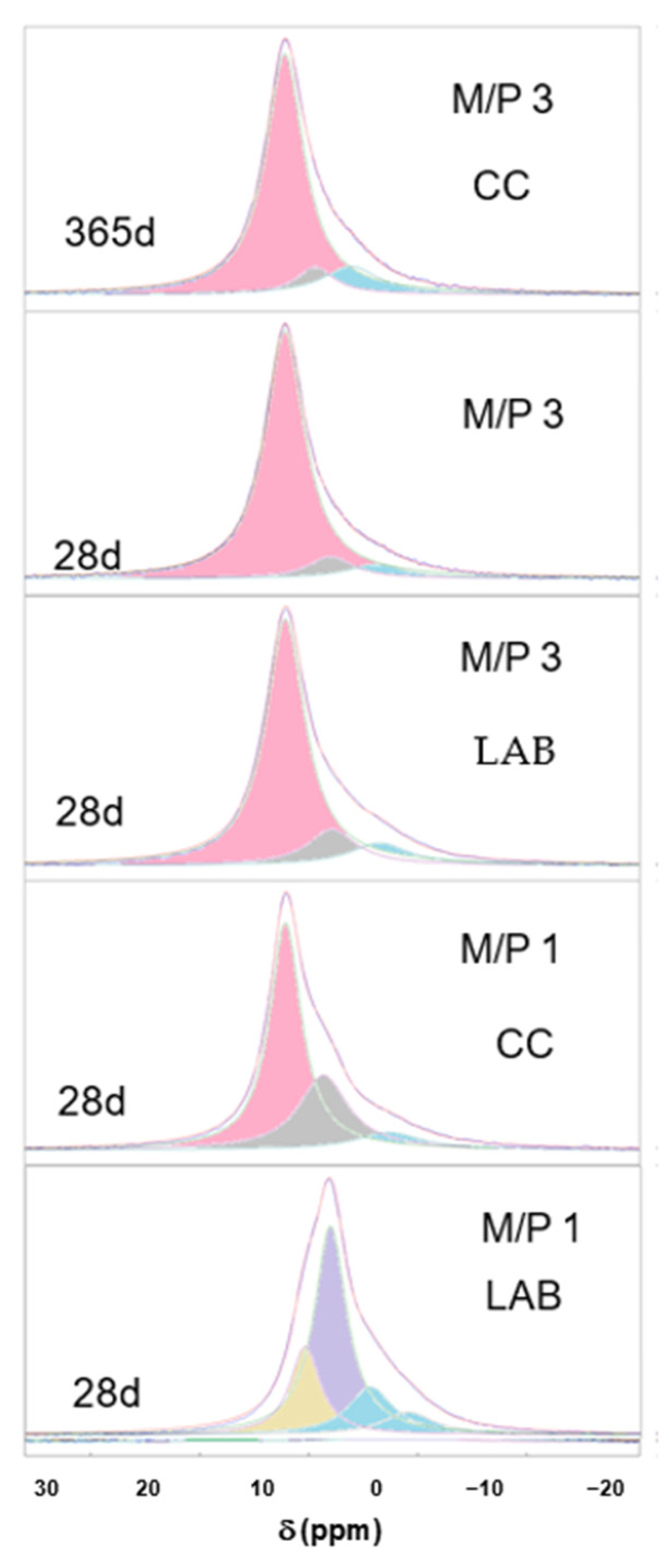
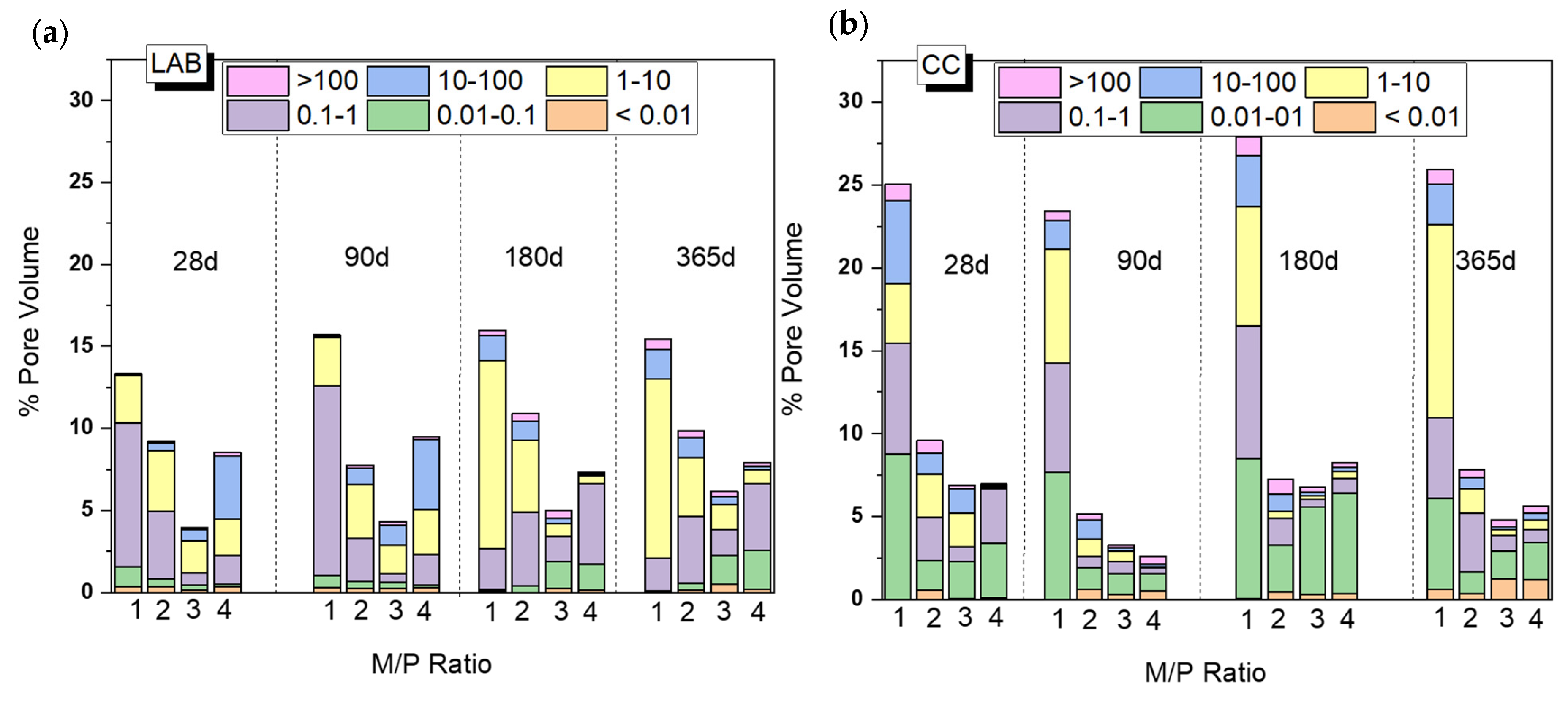
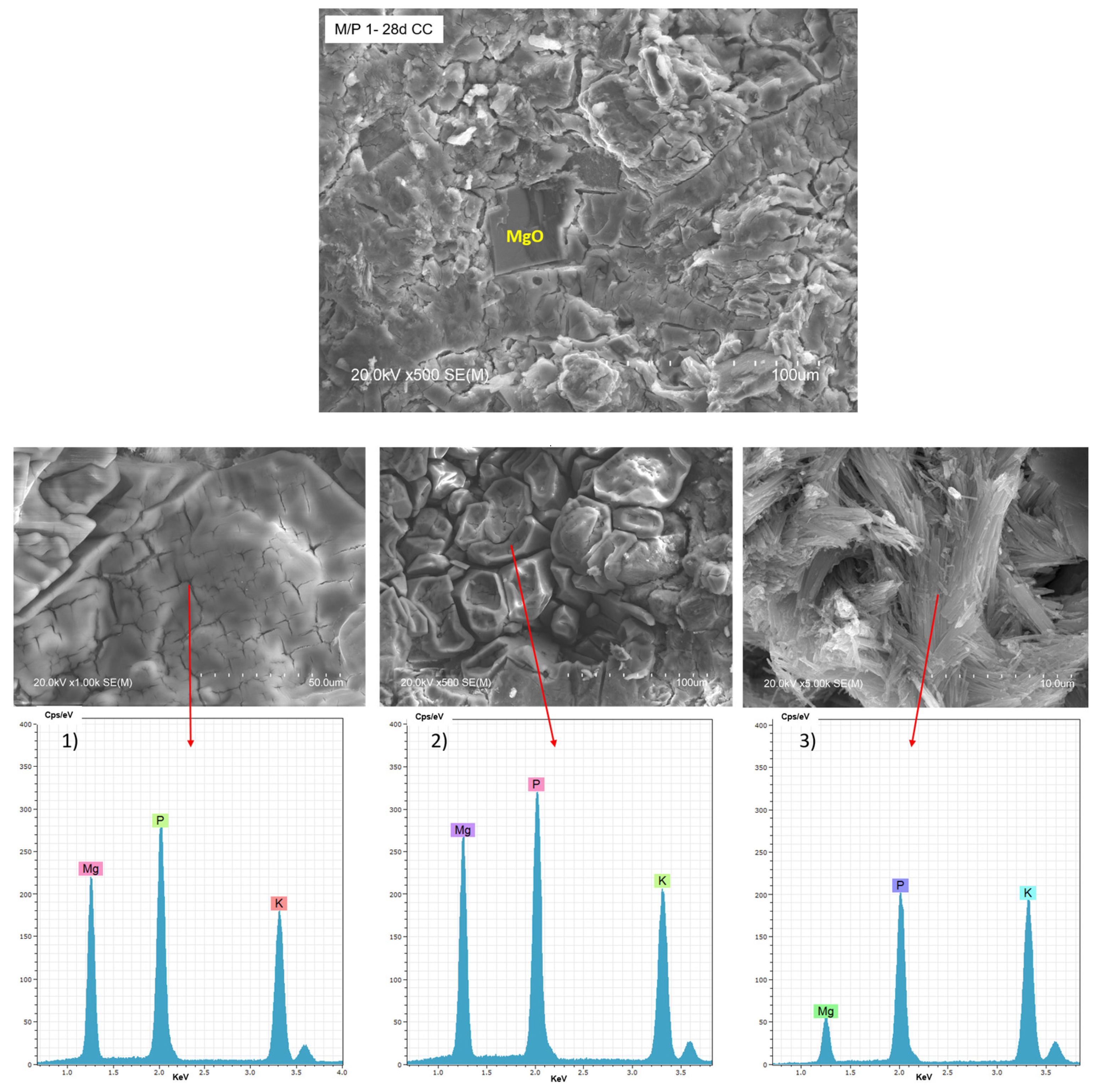
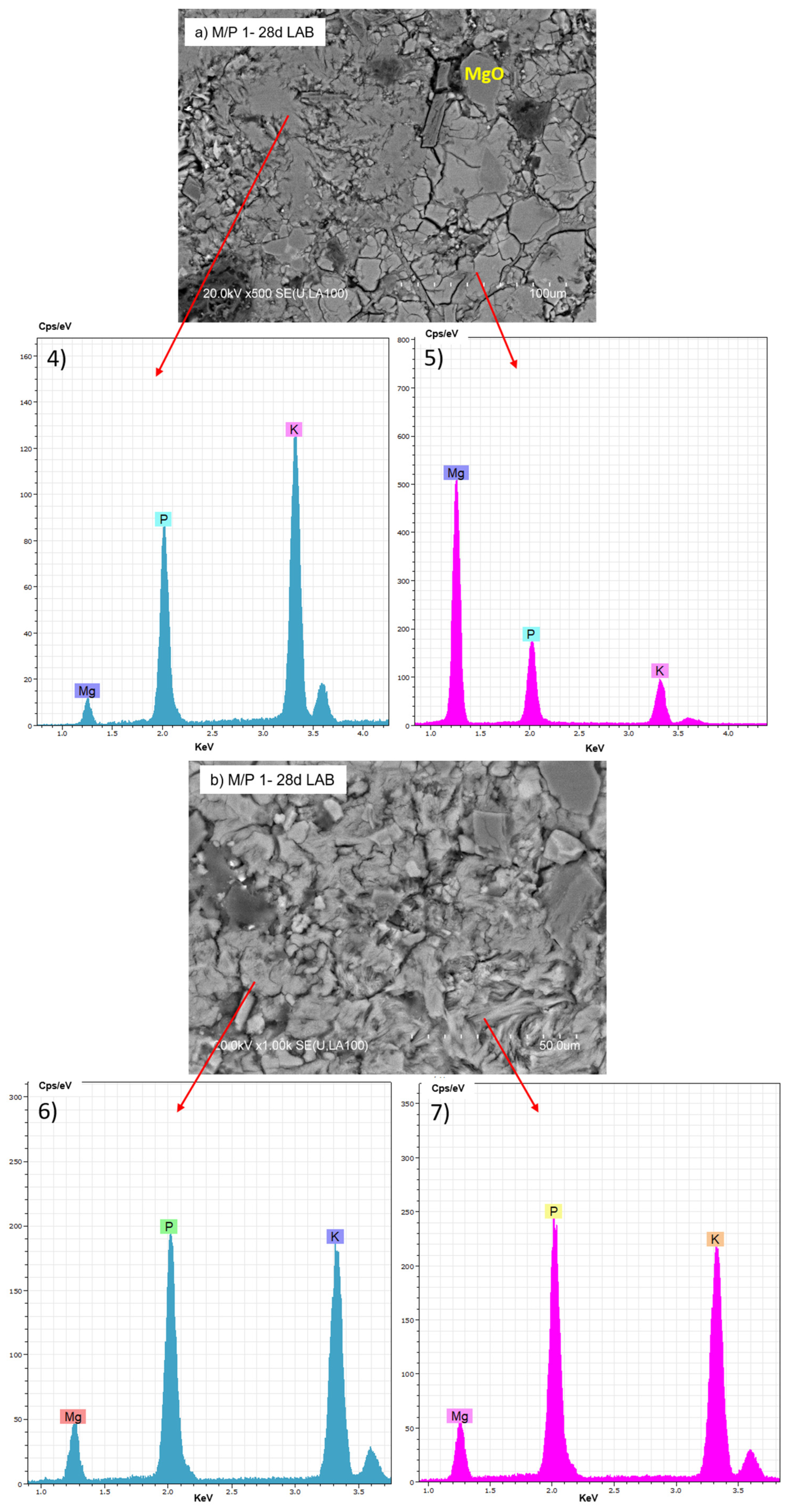
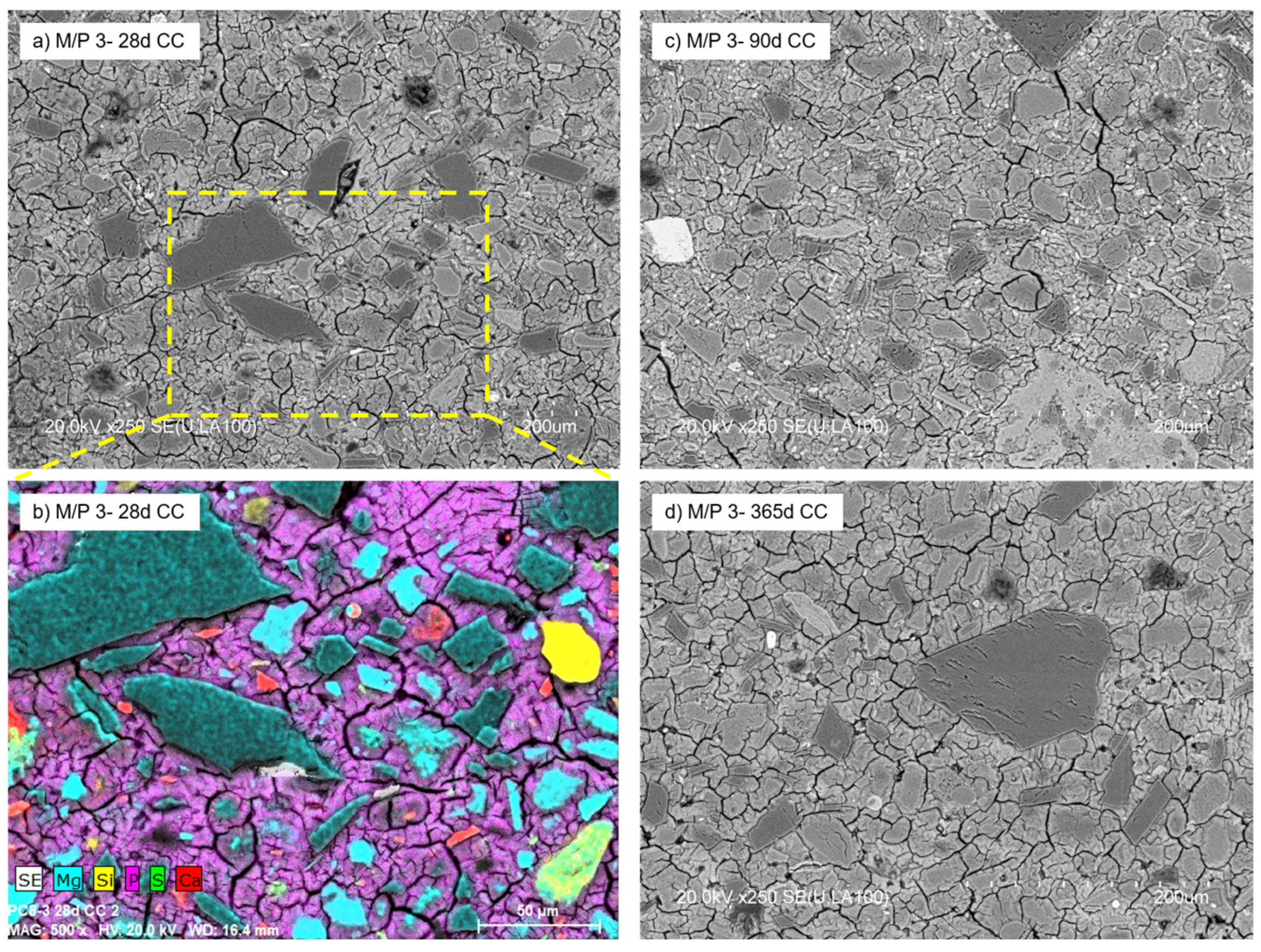
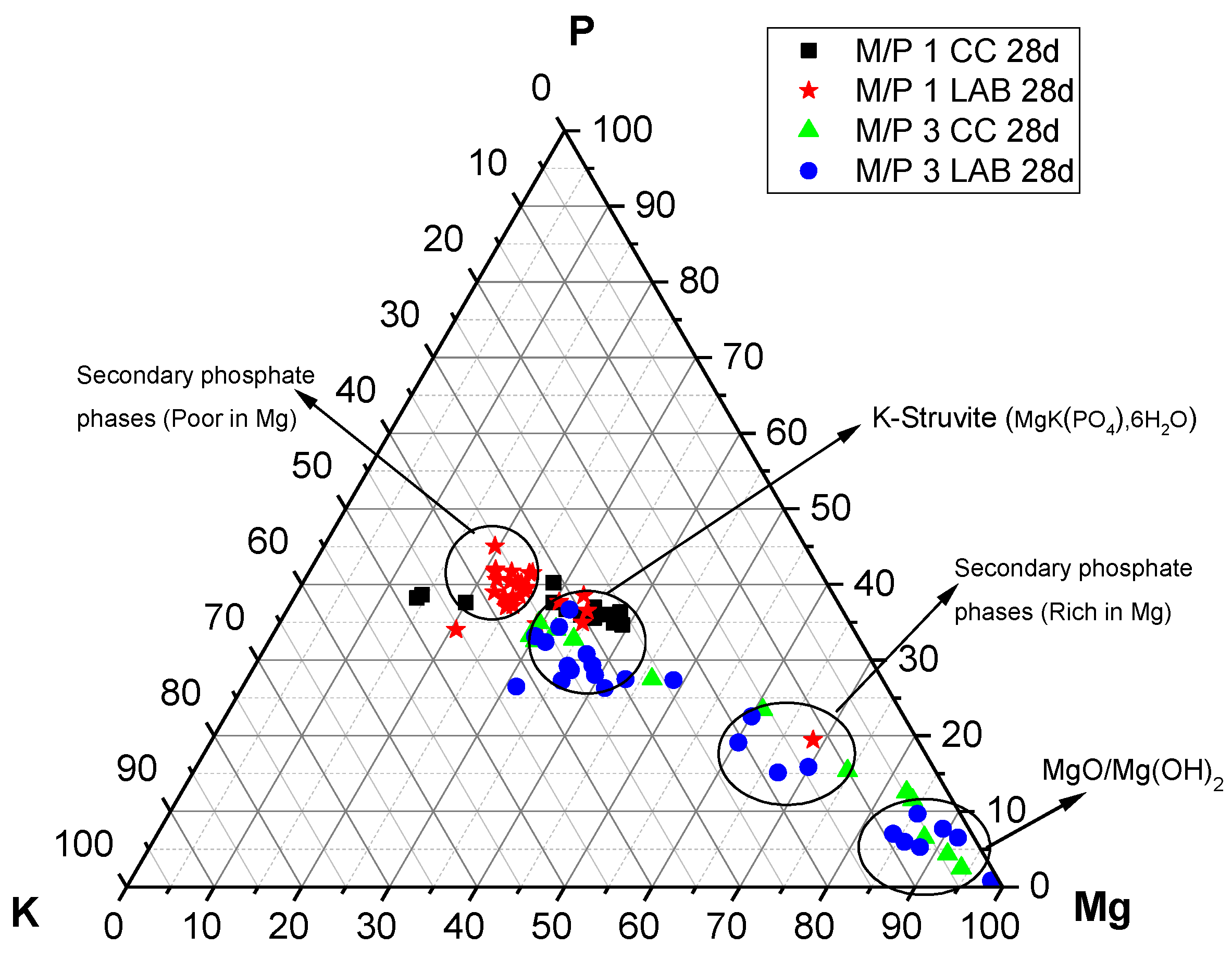
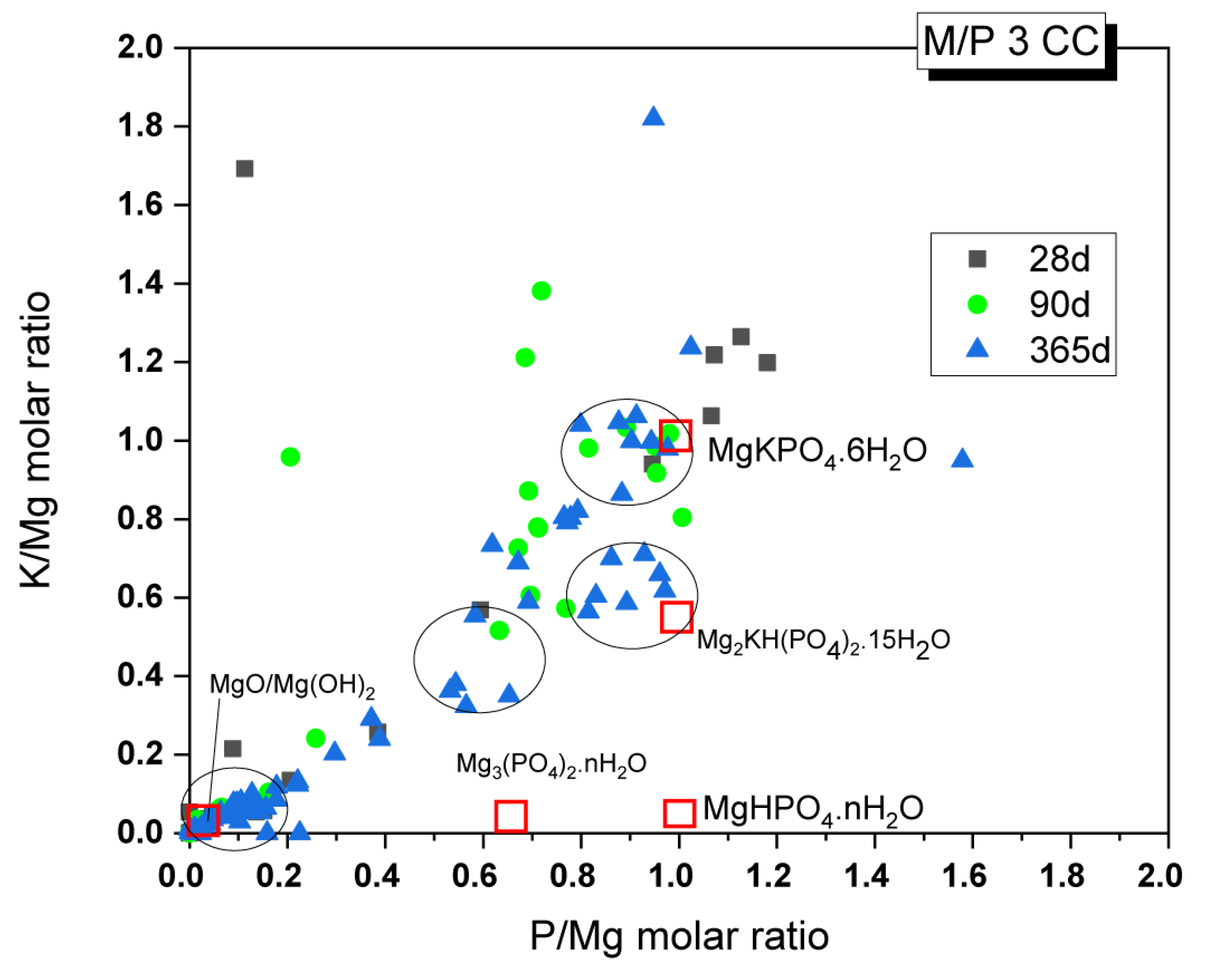

| M/P Molar Ratio * | W/B Ratio ** | LG-MgO (g) | KH2PO4 (g) | Boric Acid (g) | Sand (g) | |
|---|---|---|---|---|---|---|
| Pastes (1 × 1 × 6 cm3) | 1 | 0.25 | 44.76 | 87.40 | 2.73 | - |
| 2 | 0.25 | 43.00 | 41.96 | 1.67 | - | |
| 3 | 0.25 | 51.60 | 33.75 | 1.59 | - | |
| 4 | 0.25 | 51.60 | 25.31 | 1.38 | - | |
| Mortars (2.5 × 2.5 × 28.5 cm3) | 1 | 0.30 | 350 | 602.97 | 15.63 | 952.97 |
| 2 | 0.30 | 500 | 430.69 | 13.71 | 930.69 | |
| 3 | 0.30 | 600 | 344.55 | 13.01 | 944.55 | |
| 4 | 0.30 | 600 | 294.47 | 894.47 | 12.86 |
| Wave Number (cm−1) | Assignment | Ref. |
|---|---|---|
| ~3690 | υas H-O-H (brucite, Mg(OH)2) | [39,40] |
| ~3426, 2956 cm−1 | υas H-O-H cluster of water molecules of crystallization | [27] |
| ~2393 cm−1 | υas HOH cluster of water molecules of crystallization | [27] |
| ~1260 cm−1 | δ OH deformation vibration of water/symmetric stretch of (P=O) bonds, υs(P=O) | [27] |
| ~1450–1440 cm−1 | υas CO (CO32−)/magnesite–dolomite | [27,40] |
| ~1120 cm−1 | υas POP (PO3−), υas S-O (anhydrite), υas Si-O (quartz) | [27,39,40] |
| ~1015–1020 cm−1 | υas P-O (PO4) K-struvite | [37,38,40] |
| ~883 cm−1 | Wagging modes of coordinated water (K-struvite) | [37,38,40] |
| ~784 cm−1 | υas P-O K-struvite | [37,38,40] |
| ~746–754 cm−1 | υ C-O magnesite | [38,40] |
| ~571–575 cm−1 | δ P-O-P, K-struvite/δ P-O-P (PO43−) | [37,38,40] |
| ~435–440 cm−1 | δ P-O-P, K-struvite and/or δ(P=O) | [37,38,40] |
| δ ppm (Area %) | ||||
|---|---|---|---|---|
| M/P 3 CC 365 d | +6.45 ppm (78.76%) | +3.68 ppm (8.44%) | +0.46 ppm (12.80%) | |
| M/P 3 CC 28 d | +6.44 (85.12%) | +2.28 ppm (8.30%) | +0.40 ppm (6.59%) | |
| M/P 3 LAB 28 d | +6.39 ppm (76.46%) | +2.16 ppm (13.56%) | −1.16 ppm (9.98%) | |
| M/P 1 CC 28 d | +6.38 ppm (60.14) | +2.63 ppm (30.60%) | −2.4 ppm (9.26%) | |
| M/P 1 LAB 28 d | +5 ppm (53.65%) | +2.4 ppm (20.46%) | −0.63 ppm (16.88%) | −4.64 ppm (9.01%) |
Disclaimer/Publisher’s Note: The statements, opinions and data contained in all publications are solely those of the individual author(s) and contributor(s) and not of MDPI and/or the editor(s). MDPI and/or the editor(s) disclaim responsibility for any injury to people or property resulting from any ideas, methods, instructions or products referred to in the content. |
© 2025 by the authors. Licensee MDPI, Basel, Switzerland. This article is an open access article distributed under the terms and conditions of the Creative Commons Attribution (CC BY) license (https://creativecommons.org/licenses/by/4.0/).
Share and Cite
Garcia-Lodeiro, I.; Chhaiba, S.; Husillos-Rodriguez, N.; Palomo, Á.; Kinoshita, H. Development of Magnesium Phosphate Cement Based on Low-Grade MgO. Materials 2025, 18, 1198. https://doi.org/10.3390/ma18061198
Garcia-Lodeiro I, Chhaiba S, Husillos-Rodriguez N, Palomo Á, Kinoshita H. Development of Magnesium Phosphate Cement Based on Low-Grade MgO. Materials. 2025; 18(6):1198. https://doi.org/10.3390/ma18061198
Chicago/Turabian StyleGarcia-Lodeiro, Ines, Salma Chhaiba, Nuria Husillos-Rodriguez, Ángel Palomo, and Hajime Kinoshita. 2025. "Development of Magnesium Phosphate Cement Based on Low-Grade MgO" Materials 18, no. 6: 1198. https://doi.org/10.3390/ma18061198
APA StyleGarcia-Lodeiro, I., Chhaiba, S., Husillos-Rodriguez, N., Palomo, Á., & Kinoshita, H. (2025). Development of Magnesium Phosphate Cement Based on Low-Grade MgO. Materials, 18(6), 1198. https://doi.org/10.3390/ma18061198






